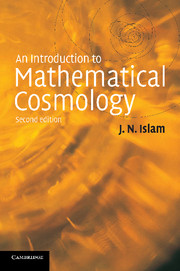Book contents
- Frontmatter
- Contents
- Preface to the first edition
- Preface to the second edition
- Dedication
- 1 Some basic concepts and an overview of cosmology
- 2 Introduction to general relativity
- 3 The Robertson–Walker metric
- 4 The Friedmann models
- 5 The Hubble constant and the deceleration parameter
- 6 Models with a cosmological constant
- 7 Singularities in cosmology
- 8 The early universe
- 9 The very early universe and inflation
- 10 Quantum cosmology
- 11 The distant future of the universe
- Appendix
- Bibliography
- Index
3 - The Robertson–Walker metric
Published online by Cambridge University Press: 03 February 2010
- Frontmatter
- Contents
- Preface to the first edition
- Preface to the second edition
- Dedication
- 1 Some basic concepts and an overview of cosmology
- 2 Introduction to general relativity
- 3 The Robertson–Walker metric
- 4 The Friedmann models
- 5 The Hubble constant and the deceleration parameter
- 6 Models with a cosmological constant
- 7 Singularities in cosmology
- 8 The early universe
- 9 The very early universe and inflation
- 10 Quantum cosmology
- 11 The distant future of the universe
- Appendix
- Bibliography
- Index
Summary
A simple derivation of the Robertson–Walker metric
As we saw in the first chapter, the universe appears to be homogeneous and isotropic around us on scales of more than a 100 million light years or so, so that on this scale the density of galaxies is approximately the same and all directions from us appear to be equivalent. From these observations one is led to the Cosmological Principle which states that the universe looks the same from all positions in space at a particular time, and that all directions in space at any point are equivalent. This is an intuitive statement of the Cosmological Principle which needs to be made more precise. For example, what does one mean by ‘a particular time’? In Newtonian physics this concept is unambiguous. In special relativity the concept becomes well-defined if one chooses a particular inertial frame. In general relativity, however, there are no global inertial frames. To define ‘a moment of time’ in general relativity which is valid globally, a particular set of circumstances are necessary, which, in fact, are satisfied by a homo-geneous and isotropic universe.
To define ‘a particular time’ in general relativity which is valid globally in this case, we proceed as follows. Introduce a series of non-intersecting space-like hypersurfaces, that is, surfaces any two points of which can be connected to each other by a curve lying entirely in the hypersurface which is space-like everywhere.
- Type
- Chapter
- Information
- An Introduction to Mathematical Cosmology , pp. 37 - 59Publisher: Cambridge University PressPrint publication year: 2001

